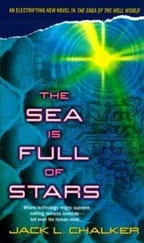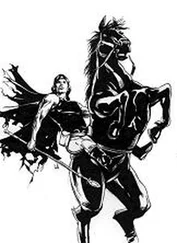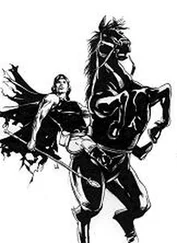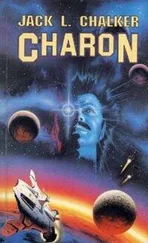“Not with the percentage Vaticanus would demand. And I don’t think Normie was the religious type, and definitely not that kind of religious. Interesting, though, if even that was a part of the old monk’s description. They’re a strange lot, those people. I mean, which star is he talking about if he’s referring to here? The conventional one, or the almost-star that traps the Kings? That planet gives me the creeps anyway. For all its awesome beauty, the fact that it’s active enough to send out light and heat on its own, and that kind of throbbing luminescence on what should be the dark side… I don’t know.”
The captain’s voice interrupted them. “I am placing us in a medium orbit above Kaspar as we speak. On the way out, I will launch a mapping satellite that should be able to produce an excellent and detailed surface study over time. Do you want to just look over the place with the screens now, or send down a surface probe?”
“We just want an overview for now,” Nagel told her. “We’ll launch a probe if we see anything we really want to look at.”
At 180 kilometers above the planet-sized moon, the instrumentation and cameras could do an excellent job. If somebody had stopped off there and left graffiti on a rock, they could read it. The trick was noticing the rock in the first place.
It was a forbidding-looking place. The residual heat from the big and still officially unnamed mother planet, plus pressure deep under its oceans, freezing around the coasts but still liquid for most of their expanse, allowed it to maintain a barely habitable temperature during its long semi-night, but just gave an even more eerie look to the place.
“Not any signs of glaciation,” Nagel noted. “It must melt pretty good on the sunward leg. Lots of erosion in the regions against the mountains, but the main land masses have been so chewed up they’re just cold, powdery desert. Those dunes and that wind would make it even nastier. And we thought that overrun colony’s choice of worlds was bad!”
“Could you breathe down there? Without aid?” An Li asked him.
He checked the figures. “Yes, looks like it. Pretty damned cold at the moment and dry as a bone, but the oxygen and nitrogen mix is within our limits. I wouldn’t like to do it without some sort of facemask to keep the grit from choking you, but the air would be okay. I don’t know what you’d eat, though, and any fresh water in those big lakes would take a fission reactor to properly melt for use. It’s probably as ugly but very different on the solar traverse. No way to tell until we can see it, and that’s still almost fifteen standard days, I think.”
A subsurface scan showed even more similarities to the old world they’d grown to hate.
“We’ve found a good second home for that worm, though,” Randi noted. Lots of caverns, vast openings beneath the surface. You could get lost in there fast.”
“Yeah, but not much water in them, interestingly enough,” Nagel pointed out. “Most of the interior caverns, some of which seem to go way down, appear to be relatively dry, and those figures there just might indicate some running water even at this point. That’s how you survive the cold cycle. Ten to one the caves maintain an above-freezing temperature that’s either constant or nearly so. The surface is only comfortable half the year. Odd, though.”
“Huh? What?” Queson responded.
“Well, caverns of that signature tend to be sedimentary rock, easily eroded away over time by the underground rivers and streams, and certainly all the makings are there for a classic setup. Note, though, that there are no such caverns within a hundred or more kilometers of the coastlines. They’re away from the oceans and in the highlands no matter where you look. There doesn’t seem to be a major change in bedrock composition in most of those cases that would explain it. The planet’s got a heavy but mostly solid core that’s maintained the gravity and kept the atmosphere, but a lot of the underground water doesn’t seem to obey the laws all that well. It’s probably scrambled data from all this interference, but on the face of it it seems like as many of those deep rivers are flowing upward as down slope.”
“Water does not run uphill. Even I know that, ” An Li commented.
“Precisely my point. Either these readings are wrong, or the signals are being distorted before sending back, or we have here a good example of the repeal of the law of gravity.”
“Water in pipes or under pressure can flow up, down, or anywhere at all,” An Li pointed out.
“Plumbing for a race driven from the surface? Interesting idea, but we’re getting heavy organics but nothing that would suggest a civilization or even a big colony that would justify building works like that. If your aliens are down there, then they’re probably long dead or reduced to a primitive existence. This is a planet you can survive on, it’s not one you ever want to try and live and work on if you don’t have to.”
An Li settled back in her chair and looked at the passing parade of the dismal, cold world below. Suddenly she sat bolt upright. “What the hell was that ?” she almost shouted. “Go back! Go back!”
“What? What did you see?” Nagel and Queson both prompted her.
“A structure! I’d swear it wasn’t natural! Cap, can you back up the video ten seconds at a time?”
“Will do,” the captain’s voice responded, and the visual segment began the backing up. An Li was almost ready to admit that she’d been hallucinating when, suddenly, it showed up again, and this time they all saw it.
“There! Freeze that!”
It did look very much like an artificial structure, but not for humans. It also gave off virtually no power signatures, meaning either that it used a power system unknown to them and therefore unmeasurable or, more likely, that it was a derelict from times long past, covered and then uncovered by the shifting sands.
It was a huge ball shape, perhaps 300 meters across, sticking out of the sand. It was light gray in color, and all over its surface it had short probelike protrusions. A closeup didn’t reveal much more about it, but it did reveal at least one clear breach of the hull or exterior or whatever it was. A jagged hole, half in the sand and possibly anchoring it there.
“It’s nothing natural, that’s for sure,” Nagel agreed. “And I doubt that it’s much of anything from any kind of ancient Kasparian civilization. That leaves the obvious, boys and girls. We’ve just discovered our first-in-history, honest-to-goodness alien spacecraft.”
“Yeah. Too bad we ain’t in the salvage business any more,” Sark growled, tongue a bit in cheek.
“He’s right,” Queson noted, not echoing the humor. “There’s a lot of potential down there, but it’s not what we’re here for. If you look at the size of that thing, even the Stanley isn’t big enough to handle it whole, and we don’t have aboard all the equipment to break it up even if we knew how to do it properly and save what’s valuable. If, that is, we could figure out what was valuable. No, we have to plot it, mark it, and go on, I think. When we can stabilize that wild hole and turn it into a genhole, if that’s possible, then it’s possibly the most valuable thing here. Until then, it’s more valuable if others come to it.”
“Man! Goes against all my instincts, though!” Nagel sighed. “Damn! Even I would love to go down there and look through that ship.”
Queson wasn’t so enthusiastic. “Yeah, that’s right. None of you have ever talked to an alien close up, have you? Still, you got to wonder.”
“Huh? What?” Nagel asked.
Читать дальше












